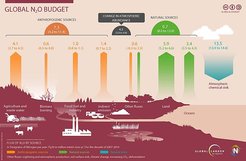Nitrogen fertilization fuels climate change

Nitrous oxide is a potent greenhouse gas in the atmosphere and its concentration has been increasing in the past decades due to emissions from various anthropogenic activities. The objective of the new study was to produce the most comprehensive assessment of all sources and sinks of this greenhouse gas. This challenge was tackled by an international consortium of 57 scientists from 48 research institutions in 14 countries, among them director Sönke Zaehle from Max Planck Institute for Biogeochemistry in Jena, Germany, which was coordinated under the umbrella of the Global Carbon Project and the International Nitrogen Initiative by the Auburn University (Alabama, USA).
From pre-industrial levels nitrous oxide concentration has risen by 20 percent and contributes currently with 7 percent to global warming. This rise is alarming especially as the sources are difficult to reduce and nitrous oxide remains in the atmosphere longer than a human lifetime.
“The dominant driver of the increase in atmospheric nitrous oxide comes from agriculture, and the growing demand for food and feed for animals will further increase global nitrous oxide emissions,” explains first author Hanqin Tian, director of the International Center for Climate and Global Change Research at Auburn University’s School of Forestry and Wildlife Sciences and Andrew Carnegie Fellow. The study also determined that the largest contributors to global nitrous oxide emissions come from East Asia, South Asia, Africa and South America. Emissions from synthetic fertilizers dominate releases in China, India and the U.S., while emissions from the application of livestock manure as fertilizer dominates releases in Africa and South America, the study found. The highest growth rates in emissions are found in emerging economies, particularly Brazil, China and India, where industrial farming with high yield crop production and livestock numbers have increased. The co-authors agreed that the most striking result of the study was the finding that current trends in nitrous oxide emissions are not compatible with pathways consistent to achieve the climate goals of the Paris Climate Agreement.
The overall increase in nitrous oxide emissions is counteracting the efforts to limit global warming. “The rising emissions of nitrous oxide but also of other important greenhouse gases such as carbon dioxide contribute to the ongoing global warming. The temperature goals of the Paris agreement will be missed without a fast reduction of emissions”, states Sönke Zaehle. To meet the goals of the Paris agreement, a reduction of N2O emissions, accompanied by a significant reduction in CO2 emissions, is urgently needed.
“Europe is the only region in the world that has successfully reduced nitrous oxide emissions over the past two decades,” Wilfried Winiwarter, Senior Research Scholar at IIASA Air Quality and Greenhouse Gases Program, Austria and co-author said. “Industrial and agricultural policies to reduce greenhouse gases and air pollution and to optimize fertilizer use efficiencies have proven to be effective. Still, further efforts will be required, in Europe as well as globally.”
Study co-leader Josep “Pep” Canadell, chief scientist in the Climate Science Center at the Australia-based Commonwealth Scientific and Industrial Research Organisation and executive director of the Global Carbon Project, agreed that the research is significant and urgent. “This new analysis calls for a full-scale rethink in the ways we use and abuse nitrogen fertilizers globally and urges us to adopt more sustainable practices in the way we produce food, including the reduction of food waste,” Canadell said. “These findings underscore the urgency and opportunities to mitigate nitrous oxide emissions worldwide to avoid the worst of climate impacts.”
[Based on a press release by Auburn University, Alabama, USA]
Reference
Tian H, Xu R, Canadell JG, Thompson RL, Winiwarter W, Suntharalingam P, Davidson EA, Ciais P, et al. (2020).
A comprehensive quantification of global nitrous oxide sources and sinks. Nature
DOI: 10.1038/s41586-020-2780-0
Contact at Max Planck Institute for Biogeochemistry
Dr. Sönke Zaehle
phone: +493641 57-6300
szaehle@bgc-jena.mpg.de
